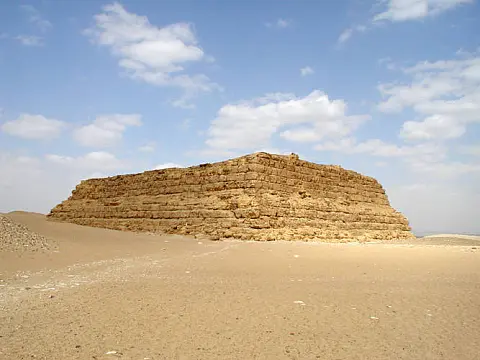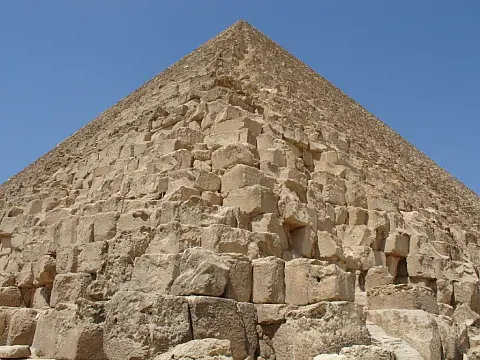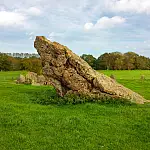Mysteries of the Ancient Egyptian PyramidsMysteries of the Egyptian Pyramids explained, history of the pyramids, how were the pyramids built and why were the pyramids built.
The Egyptian pyramids are among some of the oldest surviving stone structures. The oldest pyramid is the Pyramid of Zoser located in Saqqara which dates back to around 2700 BC. The stepped design is thought to have been influenced by the ziggurats of Mesopotamia dating back as far as 4000 BC.
Throughout the years the design had evolved from the stepped ziggurat to the classical pyramid shape. When they were constructed, pyramids such as Khufus Pyramid would have polished surfaces from the base to the capstone and shine out for miles in the sun.
Before pyramids were built, the kings of the Old Kingdom were buried inside mastabas (houses of eternity). These were mud-bricked buildings constructed of inward-sloping walls. They were always constructed on a north-south alignment which the Egyptians believed was essential for access to the afterlife. As with the pyramids, kings and queens of the Old Kingdom were buried with treasures and offerings. Tomb raiders would try to gain access to the burial chambers to steal gold and other valuable gemstones, jewellery and any other offerings they could take. Because of this, the Egyptians developed more and more elaborate designs for keeping tomb raiders out.
How Many Pyramids Did the Egyptians Build?
In 1842, Karl Richard Lepsius produced the first modern list of pyramids, now known as the Lepsius list of pyramids, in which he counted 67. Since then many more have been discovered and now there are at least 118 Egyptian Pyramids which have been identified, the most recent of which was discovered in 2008.
Why Were The Egyptian Pyramids Built?
The afterlife was an important part of Ancient Egyptian religion. This is reflected in their architecture and most prominently by the enormous amounts of time, money, and labour involved in the building of tombs. While it is generally agreed that pyramids were burial monuments, there is continued disagreement on the particular theological principles that might have given rise to them. One suggestion is that they were designed as a type of "resurrection machine."
The Egyptians believed the dark area of the night sky around which the stars appear to revolve was the physical gateway into the heavens. One of the narrow shafts that extend from the main burial chamber through the entire body of the Great Pyramid points directly towards the centre of this part of the sky. This suggests the pyramid may have been designed to serve as a means to magically launch the deceased pharaoh's soul directly into the abode of the gods.
What are the chambers in Egyptian Pyramids?
Pyramids often had many chambers and passageways hidden in their internal structure. The Great Pyramid has a King's chamber where the pharaoh was entombed, the Queen's Chamber, a lower chamber, a great gallery and various ventilation and access tunnels. Other pyramids have false burial chambers to deceive and trick would-be tomb robbers.
How were the Egyptian Pyramids Built?
One of the largest mysteries surrounding the Pyramids is the method of their construction. Estimates vary on the size of the workforce required, somewhere between 30,000 and 300,000 and recent evidence has shown that the vast majority of workers were paid. This would indicate a highly developed accounting system and hierarchical organisation. Other sources show that the workforce was made not of the slave labour commonly assumed with building the pyramids, but of highly skilled artisans.

How did the Egyptians transport such large blocks of stone to the top of the Pyramid, or even on top of the previous block? Various strategies have been suggested, including a long straight ramp, progressively getting longer and narrower as height increased, zigzag ramps up one face of the pyramid, or ramps that wrap around the pyramid.
Also, consider that summer temperatures in Egypt are 95-107F (35-41° C). How physiologically possible would it be to do this kind of hard manual labour for more than an hour in just a loin cloth under a boiling sun at that temperature? Could any pyramid work even be carried out after 11 AM? Was the pyramid constructed at night?
A more recent, controversial theory is that the blocks were "cast" in situ using limestone concrete. In this theory proposed by Joseph Davidovits, a materials scientist, soft limestone with high kaolinite content is quarried in the wadi on the south of the Giza Plateau. The limestone was then dissolved in large, Nile-fed pools until it became a watery slurry. Lime and natron were mixed in. The pools were then left to evaporate, leaving behind a moist, clay-like mixture. This wet "concrete" would be carried to the construction site where it would be packed into reusable wooden moulds and in a few days would undergo a chemical reaction similar to the 'setting' of cement. Proof-of-concept tests using similar compounds were carried out at a Geopolymer Institute in northern France and it was found that a crew of ten, working with simple hand tools, could build a structure of fourteen, 1.3- to 4.5-ton blocks in a couple of days.
The Golden Ratio and Egyptian Pyramids Design
A straight line is said to have been cut in extreme and mean ratio when, as the whole line is to the greater segment, so is the greater to the less. Euclid
In mathematics and the arts, two quantities are in the golden ratio if the ratio between the sum of those quantities and the larger one is the same as the ratio between the larger one and the smaller one. The golden ratio is approximately 1.6180.
Assuming that the height of the Great Pyramid is 146.515m, and its base is 230.363m, and using simple maths we find that half of the base is 115.182m and the "slant height" is 186.369m
Dividing the "slant height" (186.369m) by "half base" (115.182m) gives = 1.6180, which is practically equal to the golden ratio!
The Great Pyramid of Khufu
The Great Pyramid of Giza (also called the Khufu's Pyramid, Pyramid of Khufu, and Pyramid of Cheops) is the oldest and largest of the three Egyptian pyramids in the Giza Necropolis bordering what is now Cairo, Egypt, and is the only one of the Seven Wonders of the Ancient World that survives substantially intact.

Khufu was the second Pharaoh of the Fourth Dynasty (2589 to 2566 BC). Khufu is credited as being the builder of the Great Pyramid. An empty sarcophagus has been found in the King's Chamber of the pyramid, and it is unclear if it had ever been used. Khufu's mummy has never been discovered, however, two impressive and well-preserved solar barges - or Khufu ships - were discovered buried in a pit at the foot of his great pyramid at Giza in 1954 by Egyptian archaeologists.
Identified as the world's oldest intact ship and has been described as "a masterpiece of woodcraft" that could sail today if put into water. One of the barges found was inscribed with Khufu's name.
The Great Pyramid of Khufu is the largest pyramid ever built and incorporates about 2.3 million limestone blocks and granite stones, weighing between 2.5 to 15 tonnes each. The construction of the pyramid demonstrates some puzzling questions about its placement and alignment. The Pyramid lies in the exact centre of gravity of the continents. It also lies in the exact centre of all the land area of the world, dividing the Earth's land mass into approximately equal quarters.
Location of the Great Pyramid
The Great Pyramid is located at a unique point on the Earth. Its north-south axis aligned along a meridian 31 degrees east of Greenwich. This meridian has the largest total landmass of any other meridian. Even more surprising is the east-west parallel (30 degrees north), which also has the longest land parallel. Is this a coincidence, or did the Egyptians possess previously unheard-of knowledge of the whole world?

Construction of the Great Pyramid
Construction of the Great Pyramid used an estimated 2,300,000 blocks of limestone and granite, with the average block weighing 2.5 tonnes and none weighing less than 2 tonnes. The large granite blocks used in the ceiling of the King's Chamber weigh over 9 tonnes.
The Pyramid is built upon a giant platform of over 54,000 square metres that is constructed from limestone blocks, and in an official survey by the Egyptian Government, it was found that it was less than half an inch from being perfectly level. The sides are at almost perfect right angles and the difference in length between the longest (756.08 ft) and shortest edge (755.43 ft) is 7 inches. This represents an incredible degree of accuracy in the design and construction plans of the Pyramid, this level of accuracy is only recently achievable in the modern world.
Concave Faces of the Great Pyramid
In 1940, a British Air Force pilot, P. Groves, was flying over the pyramid when he noticed a strange shadow on the pyramid and captured it in the now-famous photograph.
This very unusual feature of the Great Pyramid is a concavity of the core that makes the monument an eight-sided figure, rather than four-sided like every other Egyptian pyramid. This new feature of the pyramid was not observed before 1940 as it can only be seen from the air and only under certain lighting conditions. The reason behind this concavity is unknown, as is its construction.















